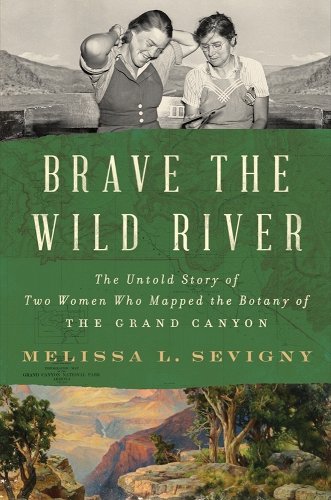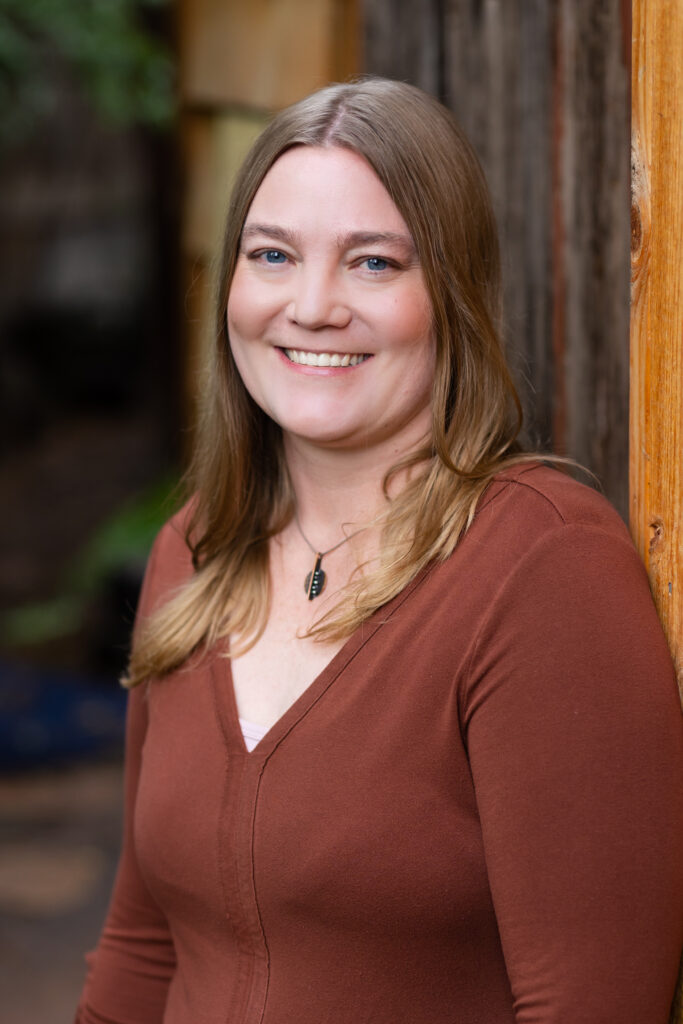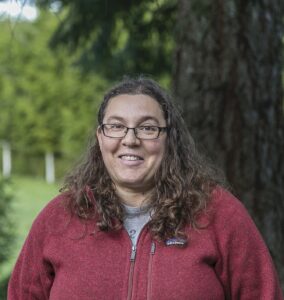Interview by Sarah Boon
 In the summer of 1938, two pioneering botanists, Elzada Clover and Lois Jotter, rafted down the Colorado River and through the Grand Canyon to collect botanical specimens. No one had surveyed the plants in the area, and they were determined to be the first. It was a trip full of dangers and obstacles, both natural and societal. Clover and Jotter were the first white women to raft the Colorado River, and newspaper headlines claimed they’d never survive the challenging trip.
In the summer of 1938, two pioneering botanists, Elzada Clover and Lois Jotter, rafted down the Colorado River and through the Grand Canyon to collect botanical specimens. No one had surveyed the plants in the area, and they were determined to be the first. It was a trip full of dangers and obstacles, both natural and societal. Clover and Jotter were the first white women to raft the Colorado River, and newspaper headlines claimed they’d never survive the challenging trip.
By piecing together a range of archives, including the journals and letters of Clover and Jotter, and those of their guide and companions, Sevigny has written a compelling book that brings readers into the world of botany on the edge–of the Grand Canyon, of women in science, and of the world of plant-collecting in general.
Brave the Wild River (W.W. Norton; May 2023) has been endorsed by several prominent writers. Christie Aschwanden says: “At a time when the Colorado River is at a crisis point, Brave the Wild River provides a captivating narrative of Clover and Jotter’s important scientific contributions along with fascinating historical details.” Alison Hawthorn Deming writes: “This book redefines the Grand Canyon not as testing ground for masculine virility but as proving ground for women’s tenacity and intelligence.”
Melissa L. Sevigny is the author of three books. Her lyrical nonfiction and poetry explores the intersections of science, nature, and history, especially in the American Southwest. Her writing has appeared in Orion, Atavist Magazine, and on NPR. She lives in Flagstaff, Arizona. I chatted with Melissa by phone on a warm spring morning in March.
Note: This interview has been edited for length and clarity.

Melissa L. Sevigny
Sara Boon: You started writing about Elzada Clover and Lois Jotter’s 1938 trip down the Colorado River in a feature article for The Atavist, right?
Melissa Sevigny: I did, yeah. Initially, I thought, “Oh, I’ll write a short little article and be done with this and move on.” And I started to write and suddenly I had 10,000 words, and I realized I was in trouble. I placed that article with The Atavist, and in the process of editing with them, I discovered that I wasn’t done, that something about that story was still calling to me. I had so much more I wanted to say. After the article was published, I posted it on Twitter. It was retweeted by an agent whose name I knew from other books that I admired, so I reached out to her and asked if she thought I could do a book and it went from there.
SB: Wow, that sounds fortuitous.
MS: Very fortuitous. Yes. And I realize that’s not the usual way for these things to happen.
SB: No, it isn’t! But your article in The Atavist was so good that I can see why somebody would want to pick it up as a longer story.
MS: Yeah, it was a very long article, and I’m really grateful for The Atavist for making space for those kinds of long form stories. But you know, I could still see gaps. I could see all of the places where there was so much more to say not just about the journey, but about the Colorado River and the history of this region, and how much has changed ecologically since 1938. It was so compelling that I just wanted to keep writing. I’m so grateful now that I’ve written the book, that the pull has dissipated, because it really kept me awake at night.
SB: So if I’m right, you wrote this on weekends?
MS: I did. I write on Saturdays. I’ve done that for years now. I started it in grad school. I had reached a point where I stopped writing entirely, I just was so overwhelmed, and I couldn’t do it anymore. And gradually, with a little help, I came up with this pattern where I get up on Saturdays, I stay in my pyjamas, I get a hot drink, and I just write until I can’t write anymore. That works really well. It gives me the mental space I need the rest of the week. I work a full time job, which gives me a little space to step away from whatever project I’m working on, and let it kind of keep working in the back of my mind. So I pretty much entirely wrote this book, on Saturdays over the course of, I guess I started in late 2018. So what is that? Four years?
SB: Yes, four and a half years or so. Were you able to do a lot of your archival research before the pandemic?
MS: Yes and no. Before the pandemic, I was working on The Atavist article, which was published in October 2019. I had based that article, largely, on Elzada and Lois’s diaries and letters, which I had copied out of two archives, one at the University of Michigan and one at Northern Arizona University.
Then when I got the agent and the contract for the book it was right at the beginning of the pandemic. I’d made big plans, when I wrote my proposal, to go to about four or five archives around the country that had relevant material. I would copy all of that material and go through all the research and then start writing the book.
And of course, the pandemic hit and so for a year or two, all I really had access to was the material that I had already copied. I think that, in retrospect, it turned out for the best because it meant that I wrote my first draft based almost entirely on Elzada and Lois’s diaries. So it really centered their voices, putting them at the forefront of the story.
Later I was able to go to the archives and get the other material: some of the men on the expedition also left diaries behind and I was able to read them. But the centreline of the story was Lois and Elzada, that’s really what made sense. That was how I wanted the story to be.
SB: Yeah, it’s interesting how limitations show us what’s really important in a story.
MS: Oh, gosh, that is so true. And you know, writing during the pandemic was so different. I used to have all these little tricks, like if I was blocked at some point I would go to a coffee shop, and the change in scenery would help. And now I realize, was that really helping me? I wrote this book on Saturdays sitting at home completely isolated for several years, like we all were, we all kind of got on with things. So now I think probably all of those little tricks I had before maybe weren’t helping me at all. Maybe I just needed to sit in a chair and write.
SB: Your book makes the reader feel that they’re on the river with the group. When I was reading it, I felt like I was there, seeing and experiencing what they were. Did you rely on a certain technique or structure to bring the story to life, given that you were working with archival material?
MS: Yeah, the structure of the book was actually a structure that was suggested to me years and years ago by one of my writing mentors, Allison Hawthorne Deming, who’s poet and essayist, and a wonderful nonfiction writer.
She said that one way to structure a story is to imagine you’re ice skating down a river, and you’ve got a destination in mind, like a hot cocoa stand at the bottom of the river. But along the way, you stop and look at things on either side; you skate from side to side. When I found this story, I knew right away that that was the structure that I wanted to use, because they’re literally going down a river. And they’ve got this goal in mind, they have to make this plant collection and they have to get through and not die. But along the way, there’s all of this opportunity to weave in the natural history of the river, the Indigenous history of the river, and other river running expeditions. There are all of these rich, rich stories that I could tap into as I move the group down the river. So I knew right away, I wanted that to be my structure.
It took me a little while to figure out that in order to do that, I couldn’t go forward in time. Initially, I was thinking “oh, well, I’ll stop here and say Glen Canyon is going to be drowned.” But that wasn’t working at all, it was a terrible, terrible plan. And it finally clicked for me that I couldn’t move forward in time.
These little side stories could only go backwards. And I started thinking of them like eddies. When you’re rafting a river, there are eddies on both sides and they only go upstream, right? So you can put in little stories that go back in time. I kind of wove in those little historical stories as I went, and that was the structure that worked for me. And yes, my goal was to make it feel very immediate. I wanted you to feel like you were in 1938. I didn’t want to stop and explain, well, they were wrong about this, or we learned this later. I didn’t want to distract the reader. I want them to feel very immersed in what Elzada and Lois felt.
SB: Talking about these little eddies: you include a lot of Indigenous history and stories, and I think it’s really important that you say the people are still there. Because I think it would have been easy to write about Indigenous people as though they were gone, or to just talk about their history. But I think it was an excellent choice to represent their current status.
MS: Yeah, and that was a craft decision I made. I talked above about how I wanted everything to feel like you were in 1938, so everything’s in the past tense. But I break that rule whenever I talk about Indigenous peoples. I move it to the present tense, because one of the major issues we’re dealing with in that region is tied to colonialism. Racism is talking about Indigenous peoples as if they’re gone, when in fact, they’re still there. So it was a craft decision to always move into the present tense whenever I talked about Indigenous history or Indigenous people.
“Racism is talking about Indigenous peoples as if they’re gone, when in fact, they’re still there. So it was a craft decision to always move into the present tense whenever I talked about Indigenous history or Indigenous people.” — Melissa L. Sevigny
SB: You’re also a poet. Does this inform your prose writing? What I’m thinking of here are your descriptions of the geological strata of the Grand Canyon. I found them very poetic.
MS: It does, yes. I started out as a poet, I wrote poetry as a child, probably since I was about eight or nine years old. And I studied poetry in college, for my undergraduate degree. The rhythms of poetry have always been in my writing. I like hearing the music of words on the page. I sometimes do some strange things with my prose to obey the rhythm that I’m hearing in my head, if that makes sense (it’s kind of weird). The funny thing is, geology was also part of what I loved as a child, I wanted to be a geologist. So getting to bring those two things together, using my skill in poetry to describe the geology of such an incredible place, was a lot of fun for me.
SB: Did you identify with either of the women?
MS: I did, in different ways. I got to know Lois first because her collection is here in Flagstaff, where I live, so I got to kind of dive into her journals and her letters. And she was just so funny, her writing was so wonderful. And then later I got to know Elzada a little better. I feel like I identified with them both in slightly different ways. Lois is probably a lot more personable than I’ll ever be. Everybody told me she was instantly the most likeable person which I will never be like that and maybe I’m a little more like Elzada, she had a little more trouble getting along with people at first glance. But I did identify with Lois when she said she’s not a particularly adventurous person, and she went on this trip because her mentor invited her and she wanted to go collect those plants. I appreciated hearing that from her because I’m not a very adventurous person either, and it’s nice to hear a story from a person who didn’t let that hold them back from doing what they wanted to do.
SB: What do you hope readers take away from this book?
MS: What a great question. I think there’re two things.
The first thing is how much has changed on the Colorado River ecologically and how many of those changes have been imposed by the way humans have decided to live in this region. It’s really in our hands what that future is going to look like, so if we care about a place as iconic and beautiful as the Grand Canyon we have to step up and look at how we’re treating it ecologically and how we can treat it better. That may sound a little trite, but what I took away from being immersed in 1938 was how many things we’ve done to this river in the past 70-plus years, and we need to be paying a little more attention.
The second thing is almost the opposite, and is how little has changed for women in science since 1938. Again I was shocked at how many parallels there were between what Elzada and Lois went through and what women in science go through today. I hope that readers take away from this book that women have always been doing science and have always been part of this vast discipline. That it doesn’t take a genius to do science, what it takes is hard work, passion, and curiosity. Anybody can do science, and if we’re going to move forward into a world where science is a key part of our society, we need to make sure that everyone representative of our society can be part of science.
 Sarah Boon’s work has appeared in Flyway Journal, The Millions, LARB, The Rumpus, Catapult, Narratively, and other outlets. She is currently writing a science memoir about her experiences as a woman in field science. She lives on Vancouver Island, Canada.
Sarah Boon’s work has appeared in Flyway Journal, The Millions, LARB, The Rumpus, Catapult, Narratively, and other outlets. She is currently writing a science memoir about her experiences as a woman in field science. She lives on Vancouver Island, Canada.


